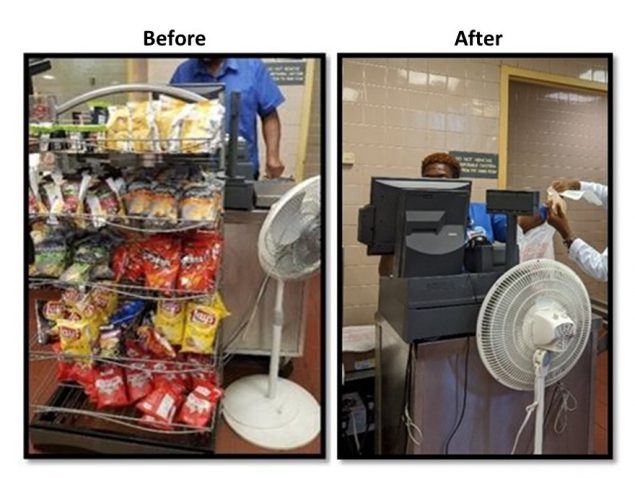New York City Gives Cafeteria Food a Heart-Healthy Makeover
Download the story [PDF – 592 KB]
Hypertension, also known as high blood pressure, is one of the most common and preventable risk factors for heart disease and stroke, two of the leading causes of death in the United States.1 In New York City (NYC), more than one in four adults have been told they have hypertension.2 One way to prevent and control hypertension is to reduce the amount of sodium in people’s diets. To help New Yorkers consume less sodium, the health department supported cafeterias in reducing the amount of sodium in their offerings.
The Health Department created the NYC Food Standards for Cafeterias/Cafes [PDF – 256 KB] (Standards) using on the latest nutrition research and guidelines. The 25 standards are meant to make healthier food and beverage options more available in cafeterias and cafes, including making water available free of charge, limiting deep-fried foods, and reducing sodium in at least half of the entrées offered. Eleven of the 25 standards address sodium reduction. The Health Department partnered with 21 local hospitals, universities, and college cafeterias to support voluntary adoption of the Standards.
Public Health Challenge
Americans consume 47% more sodium per day than is recommended.3 Nearly 70% of that sodium comes from processed, prepackaged, and restaurant foods, not from the salt shaker.4 The Health Department saw an opportunity to address this challenge by helping local cafeterias adopt the Standards.
Approach

A “before and after” of the health checkout area at St. John’s Episcopal Hospital, where unhealthy snacks were removed.
The Health Department’s team began by assessing how well each cafeteria menu lined up with the 25 standards. Following their review, the team worked with cafeteria staff to develop short-, medium-, and long-term goals for achieving standards that were not yet met, including helping to identify high sodium products, ingredients, and meal items that could be replaced with reduced sodium alternatives.
Health Department staff also worked with two national food distributors, US Foods and Sysco, to create a Good Choice list, highlighting lower sodium products available to the distributors’ customers. Good Choice, along with similar lists the team developed for cafeterias not working with US Foods or Sysco, made it easier for cafeteria staff to find and purchase lower sodium products.
Results
The 21 cafeterias have taken steps toward meeting their sodium reduction goals and remain committed to meeting the 25 standards. They continue to work to improve their offerings and prioritize the reduction of high sodium products and meals.
Participating cafeterias’ successes include the following:
- At least 50% of all sandwiches, salads, and entrées served by St. John’s Episcopal Hospital and Interfaith Medical Center are now lower in sodium.
- Staff at 15 cafeterias now arrange products in a way that makes lower sodium foods more easily accessible to customers. For example, St. John’s Episcopal Hospital created a healthier checkout area by removing high sodium snacks, and New York Community Hospital removed all advertising and promotional materials for unhealthy food and beverages.
- Cafeteria staff across all 21 sites are now collectively buying about 430 more lower sodium products per week than they were before joining the program.
- Approximately 4,570 customers at the 21 sites benefited from the lower sodium menus.
Lessons Learned
Standardize recipes. Many partners did not have standardized recipes or nutrition analysis before putting the Standards into action. The Health Department’s team developed a recipe template to make it easier for cafeteria staff to collect and share recipes and for the Health Department team to assess the nutritional content of those menu items.
Engage and recognize partners. Despite their busy schedules, cafeteria staff have made great strides in applying the Standards. The Health Department staff developed a public recognition grid [PDF – 1 MB] to help highlight their achievements, emphasize the importance of the program, and encourage continued commitment.
Get leadership buy-in. The Health Department team first met with senior leaders in the institutions’ administrations to give an overview of the program, explain its benefits, and ask for signed agreements. These steps ensured leadership engagement and allowed supervisors to support cafeteria staff in taking the time and resources needed to make any changes.
Respond to changing needs. Many plans were put on hold during the COVID-19 pandemic. Health Department staff conducted a survey of the 21 institutions to learn more about how cafeteria operations have shifted and to find new ways to provide support during challenging times, such as analyzing the nutritional content of grab-and-go meals and recommending lower sodium alternatives.
What’s Next
The Health Department is committed to continuing to help local cafeterias adopt and maintain the 25 standards. The team plans to:
- Work with a vendor to develop low sodium plant-based recipes for grab-and-go meals based on partners’ needs.
- Continue to support cafeteria staff remotely through virtual check-ins and by sharing tips and resources to reduce sodium in cafeteria offerings.
- Offer technical support for cafeterias to implement the NYC Food Standards for food and beverage vending machines.
- Encourage cafeteria staff to use self-assessment tools, including an implementation guide and action plans, to monitor their own progress.
Learn More
Learn more about the Fund for Public Health in New York City, Inc. Find out more about the New York City Department of Health and Mental Hygiene.
Use the SRCP Implementation Guide to apply sodium reduction strategies derived from the SRCP into your communities.
References
- CDC. Heart Disease and Stroke. Accessed August 9, 2021.
- New York City Department of Health and Mental Hygiene. EpiQuery: Community Health Survey 2017. Accessed August 30, 2021.
- Harnack LJ, Cogswell ME, Shikany JM, Gardner CD, Gillespie C, Loria CM, et al. Sources of sodium in US adults from 3 geographic regions. Circulation. 2017;135(19):1775–83.
- US Department of Agriculture and US Department of Health and Human Services. Dietary Guidelines for Americans, 2020–2025 [PDF – 32.5 MB]. USDA, USDHHS;2021. Accessed August 9, 2021.
